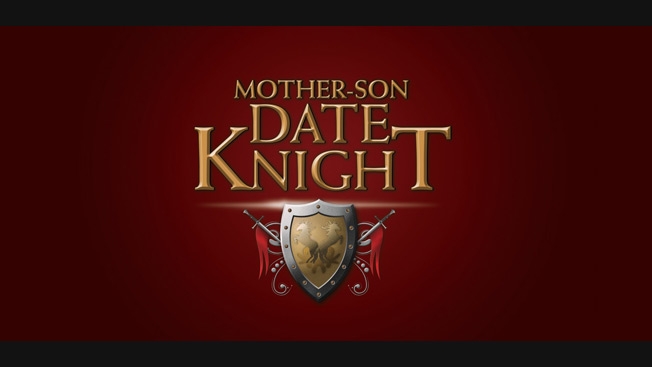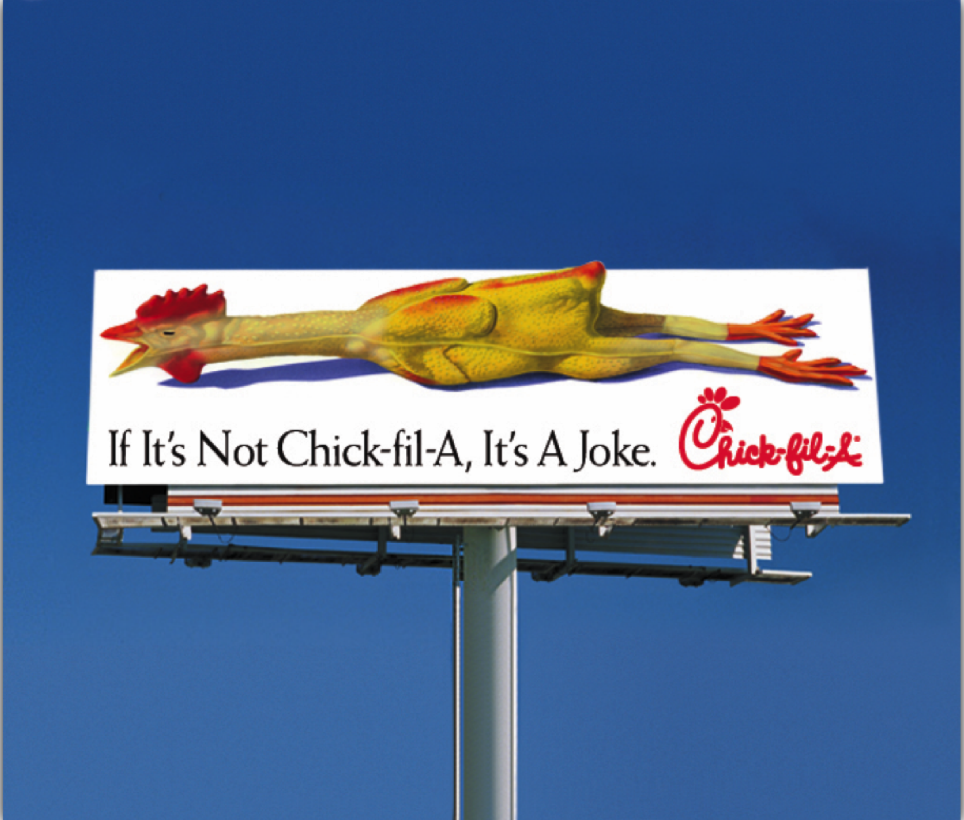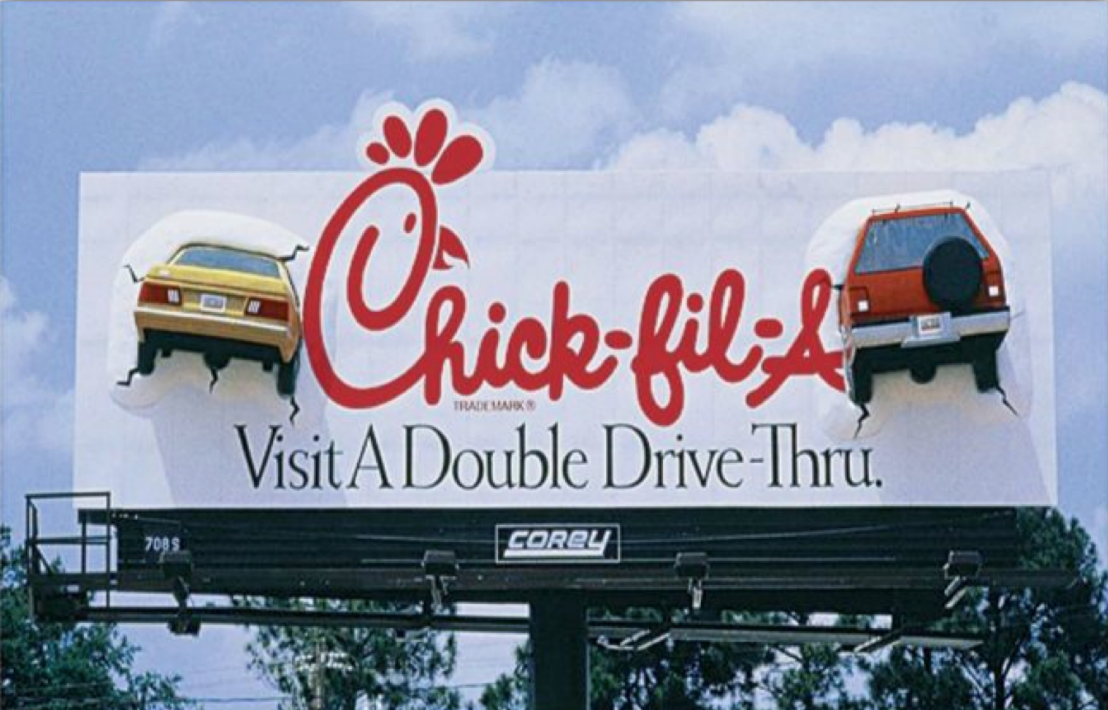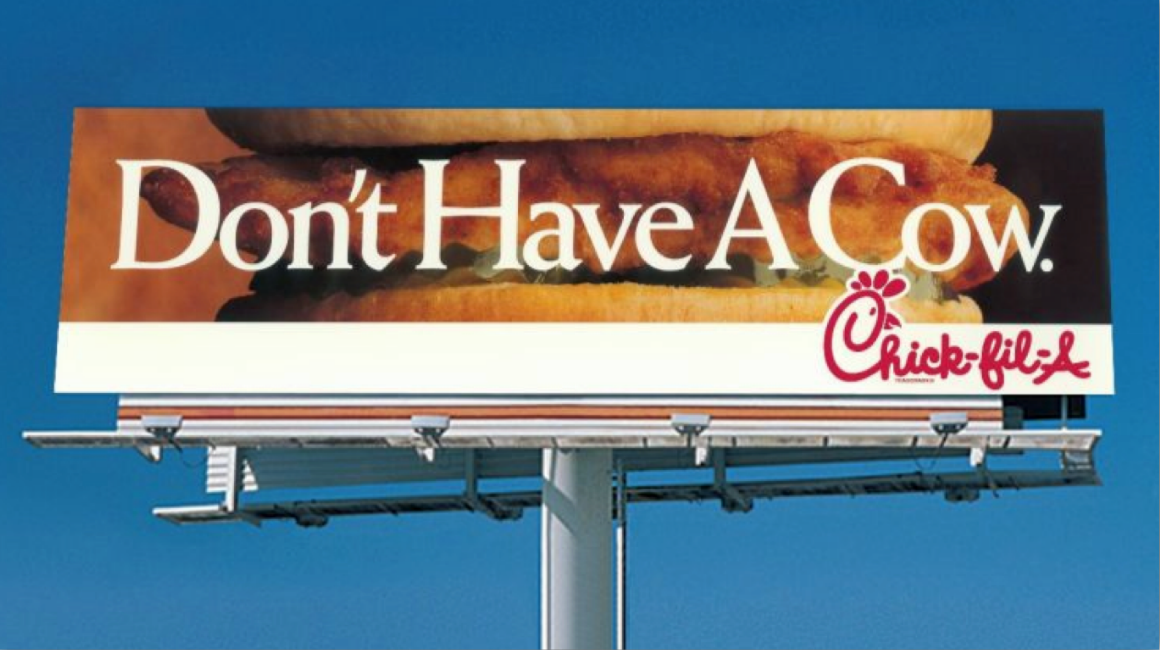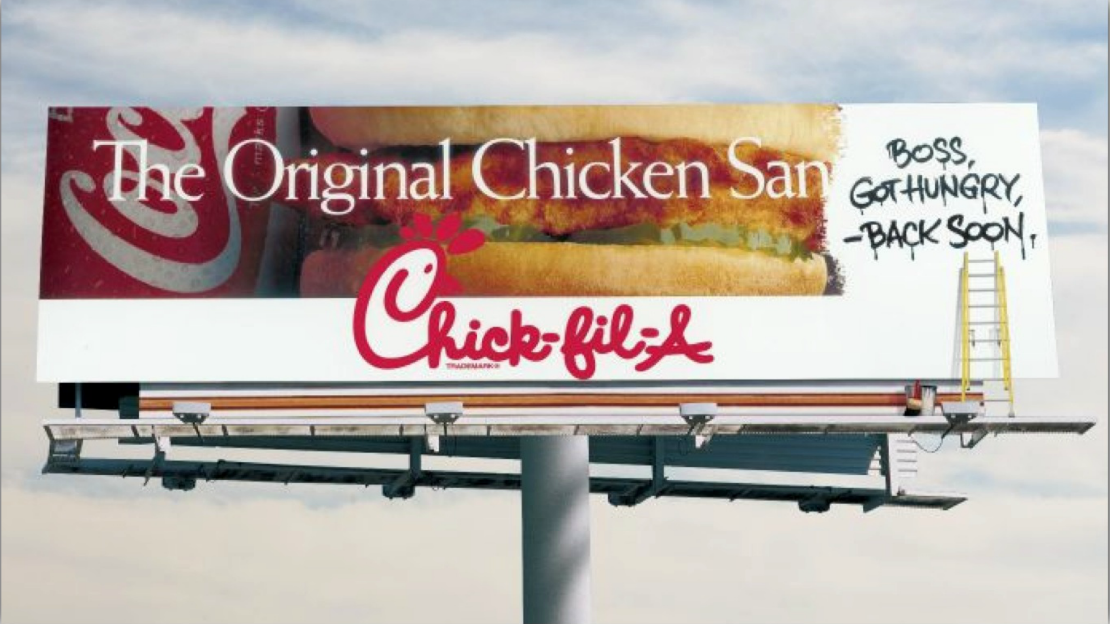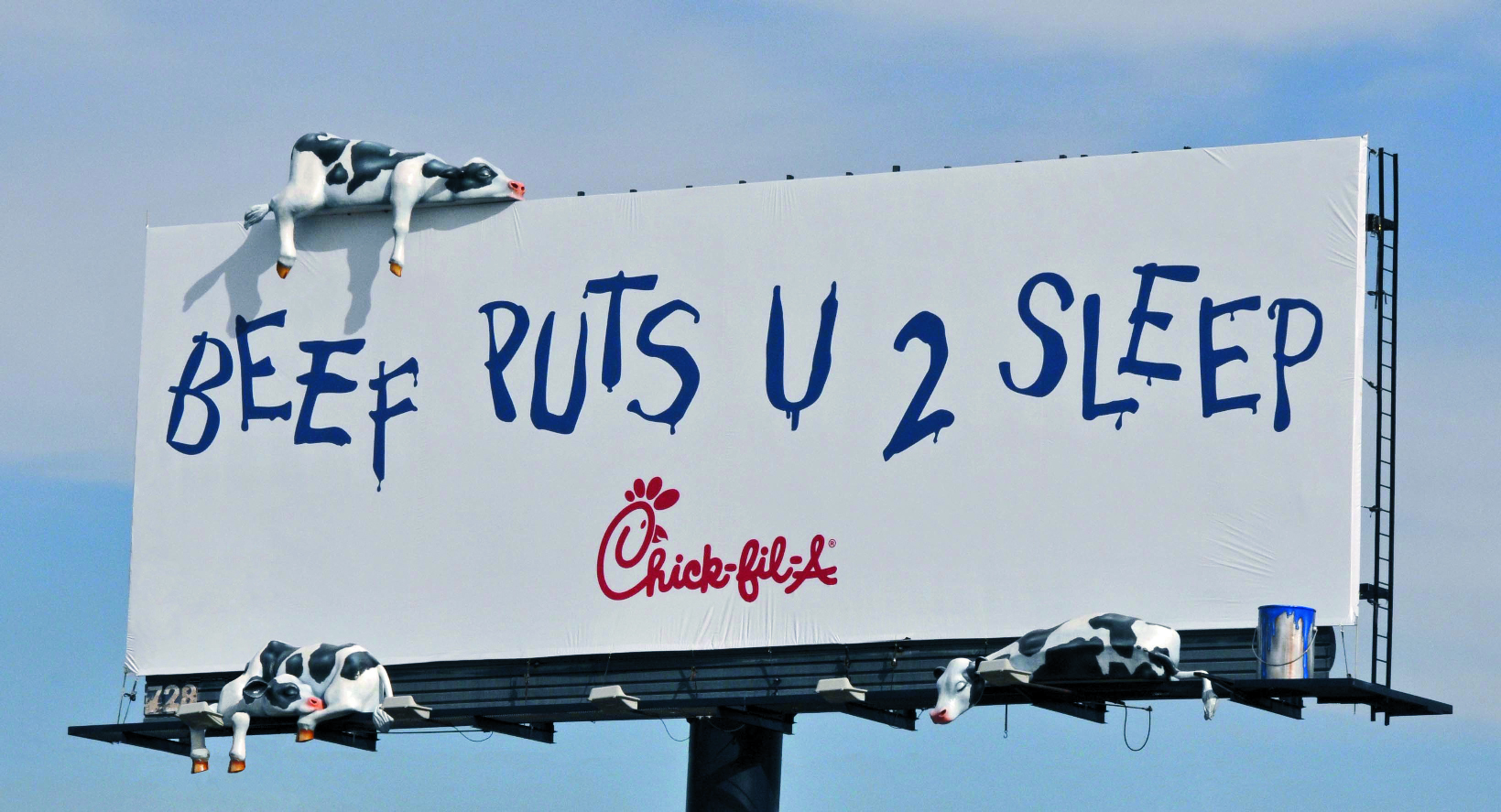![]()
Stan Richards, founder and creative director of ad agency The Richards Group, was sitting in a routine staff meeting in 1994 when he learned his agency won the Chick-fil-A account. He didn't find out in an email. No phone call came in breaking the good news. Instead, David Salyers—then vp of national and regional marketing at Chick-fil-A—ventured from Atlanta to the agency's Dallas headquarters on a whim.
Salyers arrived, unannounced, and boldly walked into the meeting. He stopped whatever conversation was taking place and shook Richards' hand. "We want you to be our new agency," he said with a smile.
In that moment, Salyers made a promise to Richards that the agency said still rings true today: "We will never be your biggest client, but we will do everything we can do to be your best client."
And, Richards tells Adweek, "that's exactly what they've done over all those years."
The underdog chicken
In the early '90s, Chick-fil-A was primarily known for being a mall-based fast-food chain, but beginning in 1994, the chain started slowly shifting its focus to freestanding units. With that shift came a new batch of competitors—big burger joints.
These chains spent more in one week on their advertising than Chick-fil-A could afford to spend in a year. Plus, the chicken chain was already at a competitive disadvantage due to its stance on all locations being closed Sundays.
The brand needed an agency that could work with its budget to create stop-you-in-your-tracks advertising campaigns and encourage more people to choose Chick-fil-A over "the other guys."
The catch? With its advertising budget constraints, Chick-fil-A couldn't afford to spend the money on a TV campaign and instead was set on relying heavily on three-dimensional billboards, something that was nearly unheard of in the advertising world then.
"At the time, a billboard campaign was extraordinarily revolutionary because conventional wisdom was billboards tell you what exit to take," The Richards Group's Rob VanGorden, a principal on the Chick-fil-A account, tells Adweek. "You don't build a brand on billboards."
The brand also suffered from what VanGorden calls "extreme back-of-mind awareness." In focus groups, the agency found that when it asked participants about their favorite fast-food chains, a Chick-fil-A mention was rare. It was only when the agency gave participants a nudge that "it brought back all the emotions of what a great place Chick-fil-A was," VanGorden recalls.
In order to get through to its desired consumers and boost awareness for the chain, The Richards Group needed a simple, visual idea that would stand out on crowded highways. So, where to begin?
Waiting for the right sign
The road to the perfect billboard—and the birth of the cow campaign—was bumpy. VanGorden credits Chick-fil-A for the client's trust and extreme patience throughout the process as the agency delivered a few "foul balls" before getting it right.
Created in 1994, the first attempt featured an image of a rubber chicken on a Dallas billboard—no logo, no tagline, just a lonesome rubber chicken. The idea was intriguing and garnered some buzz on local radio stations, but the billboard needed more substance if morning commuters were going to understand with just a glance what was being advertised.
Next, the agency slapped the Chick-fil-A logo in the bottom right corner and added the tagline, "If it's not Chick-fil-A, it's a joke," beneath the rubber chicken. It was a step closer. "A fine billboard," according to VanGorden, but the agency still hadn't managed to deliver a 3-D idea to the client. "It accomplished the mission of stopping people and making people notice, but it didn't really say the things about our brand that we wanted it to say. It didn't differentiate us in any way."
The team's next iteration, the "Double Drive-Thru" ad showing two cars that seemed to have crashed into the billboard, finally managed to incorporate some depth. Even the president of Coca-Cola at the time loved the idea, calling up the Chick-fil-A team to compliment them on the clever ad. However, the car billboard was focused solely on "product attributes." It still wasn't quite what the agency or the client was looking for.
![]()
![]()
Birth of the cows
Feeling somewhat lost in a sea of semisuccessful billboards, The Richards Group was still hunting for that big idea. The team's next attempt came one step closer, with the inspiration coming from an unlikely place—Bart Simpson.
At the time, one of Bart's most noteworthy taglines, "Don't have a cow, man!," was seeping into pop culture. It was the perfect tagline for a company selling chicken products, so the creative team borrowed it, using the line, "Don't have a cow," on a billboard next to a picture of the classic chicken sandwich. The idea was there, but again, there was no 3-D component, and the product shot wasn't what the brand wanted.
"In the QSR category, we live in a sea of sameness, and most of our competition, they're selling a product at a price point," VanGorden says.
Drive down the highway and you're likely to see a handful of billboards for fast-food chains that feature massive burgers topped with bacon and cheese or a selection of refreshing smoothies or blended beverages, all with a low price slapped next to the product to seduce hungry drivers. If Chick-fil-A was going to stand out and steal away some of the big burger chains' customers, it needed to go bigger.
Then one day, an art director on the Chick-fil-A account was driving down a Dallas highway, on his way home for lunch and a little hungry, when a billboard caught his eye. It wasn't the subject of the billboard that intrigued him but rather the people pasting up a new ad.
What would happen if the team of workers up on that billboard decided to take a lunch break midway through the task, leaving the ad unfinished? That would be kind of clever, he thought. The team took that idea and ran with it.
For its next billboard, The Richards Group put up another product shot, but the right side of the billboard was still painted white. Atop the white space, the team scrawled a note: "Boss, got hungry, back soon," with a yellow ladder posted up beneath the note. It was witty and eye catching, a good move, but there was still something missing. A bigger, better idea was out there.
Thinking back to the "Don't Have a Cow" idea, a big hit with the client, creatives from the agency started thinking of ways to fuse the idea of not having a cow with the clever tone of the most recent billboard.
That got the team thinking. Who else doesn't want people to have a cow?
Suddenly, it clicked.
Cows. Cows don't want people to eat them.
They want to keep on living, grazing and enjoying their cow lives. So why not use cows to tell the brand's story? Put a couple of cows on a billboard and have them plead with burger fans not to eat them.
And what if the cows were the three-dimensional part of the ads? They could be up there on the billboard ledges painting the messages themselves. Don't eat cows, they would plead. Eat more chicken.
And thus, the cows were born.
![]()
![]()
![]()
From humble herd to creative stampede
The idea was perfect. Fans of the chicken chain fell in love from the moment they saw that first cow duo painting its first sign—"Eat Mor Chickin," it read—in 1995. No other fast-food chain had created anything remotely similar. Everything was big budget TV spots, product shots on top of product shots and run-of-the-mill, cowless billboards.
After striking gold with the first 3-D cow billboard, The Richards Group now had a new challenge on its hands: where to take the cows from here? How long would the idea of cows telling humans not to eat them capture the hearts, minds and stomachs of chicken lovers everywhere? The answer, as it turns out, was more than 20 years—and counting.
Following the success of the initial "Eat Mor Chikin" billboard, the agency continued to find new and charming ways to introduce the cows to the world and build up their fan base. Cow creative has been plentiful over the years, from political cows around election time to to holiday cows asking Santa not to drop gifts off for beef eaters.![]()
Soon the cows found themselves on more than just billboards. In 2006, they made their debut in the Houston Astros' stadium. The brand secured prime real estate in Minute Maid Park: the foul polls, which the creative team renamed "fowl poles" and put baseball cap-wearing cows on top with the words "Eat Mor Fowl" on the side.
The fresh ideas never seem to run out. Richards estimates that for every winning idea the creative team comes up with, it discards roughly 10. It might be challenging to keep the cows in the spotlight, but the team continues to succeed.
"The whole idea is we need to keep it fresh. We need to make sure that every time somebody is exposed to the cows—whether it be in outdoor, television, wherever it happens to be—that there is something that the consumer is seeing that he or she hasn't seen before," Richards said.
The power of the cows has been proven in Chick-fil-A sales results, too.
While Chick-fil-A eventually expanded its marketing efforts, the initial billboard-focused effort helped the brand take on its biggest competitors. In 2012, Chick-fil-A scored the title of No. 1 fast-food chain in terms of sales per store, reaching $3.1 million per location. One year later, Chick-fil-A surpassed KFC in sales, despite having a smaller ad budget and closing on Sundays.
Over the years, the outdoor work has also garnered plenty of recognition within the ad industry, winning everything from a silver Lion at Cannes to a silver Effie award in 2009 for "sustained success." In 2006, the OBIE awards inducted the cows into its hall of fame. The following year, the cows made it into the Madison Avenue Advertising Walk of Fame.
![]()
![]()
![]()
A multi-moodia empire
The cow campaign has sustained itself for more than 20 years, and as it has continued to grow and become more popular with Chick-fil-A fans, the brand has expanded its marketing plan, too. In 1997 the cows came out with their first TV commercial, and the brand continues to push out TV spots from time to time.
In 1998, Chick-fil-A released its first cow calendar—which includes great cow creative as well as one promotional deal per month—and has released one each year ever since. At first, the Chick-fil-A team considered a calendar filled with product shots—January, a chicken sandwich; February, a chicken sandwich; every month, a chicken sandwich. But how many chicken sandwiches can consumers really look at? The cows were already a proven hit on billboards, TV and radio, so why not put them in one more place and give consumers a chance to bring the cows into their homes and offices?
Each year, the team picks a theme for the calendar and adds a cow spin to it. The 2012 calendar focused on historical trail blazers but called it "Trail Grazers." Ferdinand Magellan becomes Herdinan Moogellan. Louis and Clark become Loin and Clark, and Cleopatra transforms into Cleopatty. "[The calendars] are a great palette for cow creative," VanGorden says. The calendar has even sold more copies in some years than the Sports Illustrated swimsuit calendar.
The future of cows
The billboards are still an integral part of Chick-fil-A's campaigns, and they don't seem to be going anywhere anytime soon. But because the campaign was created in a time that predates social media, the cow campaign eventually needed to adapt. Rather than simply creating only brand accounts, The Richards Group helped craft a Facebook page and Twitter account just for the cows. On the different platforms, the cows manage to keep their sense of humor with all types of content from memes to short videos.
![]()
So, what makes the campaign and the cows so successful after all these years?
"There is something uniquely human about self-preservation. It's innate, the desire to preserve oneself," VanGorden says. "The cows are a great story, and what makes a story interesting is conflict. Within a story, when the conflict is resolved, the story is over. With the cows, the conflict is never resolved. People root for the low-status character, and the cows are low status. They're the underdog."






